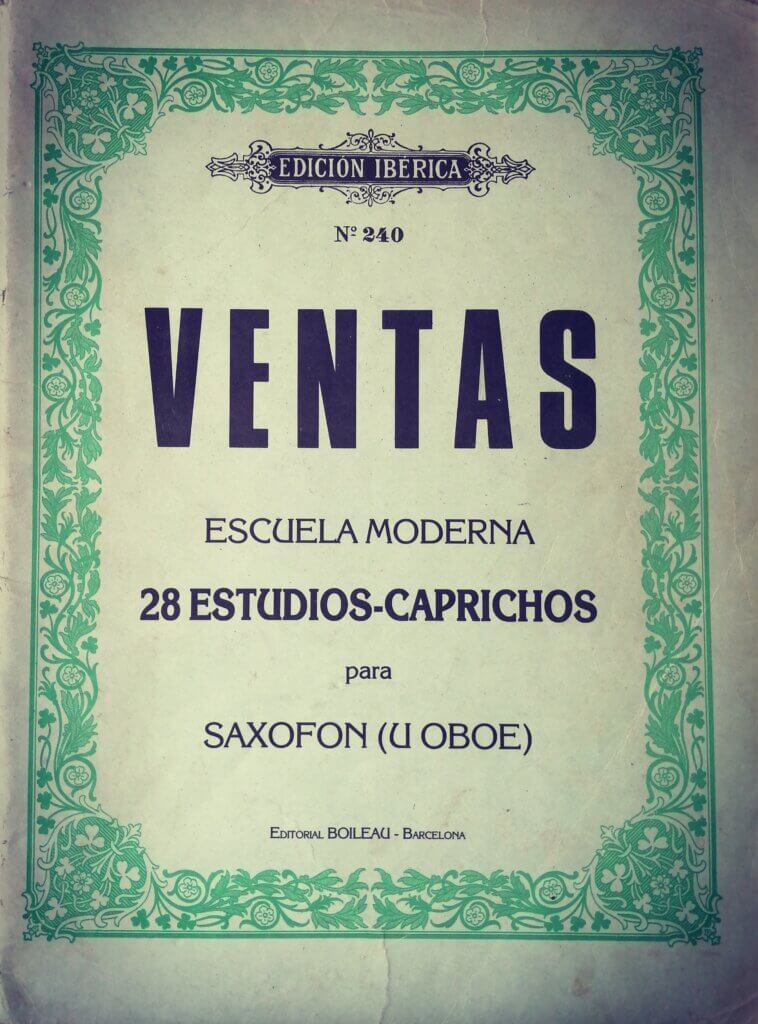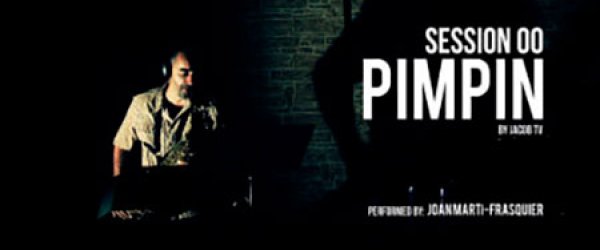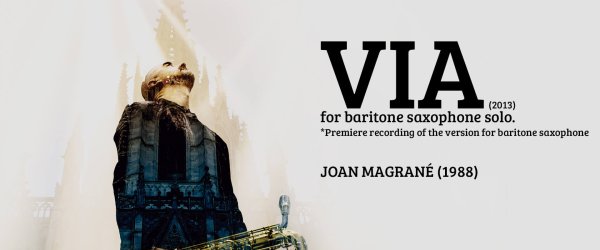
Cover of the printed edition in Editorial Boileau (Barcelona, CAT, ESP)
These 28 ESTUDIOS-CAPRICHOS are based on the 28 Messiaen’s modes of limited transposition. Far from seeming technical studies, these pieces are very expressive (even the faster ones) and work very well as concert pieces.
The Composer
ADOLF VENTAS (Amposta, 1919 – Barcelona, 2014) was a very prolific performer, pedagogue, composer and arranger. You can read his biography written by Israel Mira and others entitled “Adolf Ventas. Su vida, su música y el saxofón” (in Spanish), published by Rivera Mota (Valencia, 2003).
Ventas, as a composer, intended to enlarge and promote the original repertoire for saxophone. He spread the instrument into the Spanish classical music scene, where it still was a perfect unknown. Since the 1970s, he composed, arranged and transcribed about 80 works (the 28 ESTUDIOS-CAPRICHOS, among them). Ventas wrote for different formations: solo pieces, concertos, saxophone quartets, saxophone ensembles, etc. in addition to works for symphonic band. He also wrote some very interesting methods for saxophone.
Many of his original works are an original combination between the music by Spanish composers as Albéniz and Granados and the modal music by French composers as Messiaen. Ventas’ music sounds fresh, without excessive artifices. His slow movements sound deep and expressive and the fast ones are bright and vigorous.
Details of the work
Publisher: Boileau, Barcelona (CAT, ESP)
Duration: Around 1h 30
Range (written): Bb2 – D6 (optional). Almost all studies are composed in the normal range of the instrument (Bb2 – F#5), except from num. 17, 19 and 23 that contain few and short optional excerpts in the altissimo register.
TECHNIQUES: Very fast excerpts, tonguing accuracy, diversity of articulations, slaps, long phrases, wide intervals, breath control, rhythmic precision.
PERFORMANCE: To play with expressive energy.
Meaning and structure of 28 Estudios-Caprichos
In my opinion, Adolf Ventas still has not been fully recognized among saxophonists from Spain. His methods for saxophone have the same value than many others by European or American authors.
Although these 28 ESTUDIOS-CAPRICHOS had not been composed specifically for baritone saxophone, as a saxophonist committed to original music for the instrument, I truly recommend you to discover them. This music has been part of my training and other saxophonists in Catalunya and Spain. Furthermore, I have appreciated its great pedagogical and artistic value over time as saxophone teacher as well as performer.
Presented in the form of études for solo saxophone, Adolf Ventas reused them with different harmonizations and instrumentations. Some of best-known works are based in these études.
I will explain them you briefly one by one:
Estudio-Capricho No. 1
Written in mode I, 1st transposition, it corresponds to a whole-tone scale (or hexatonic) based on C. In a moderate tempo and 2/4 march time, the character of the étude is rhythmic and contains some fast excerpts.
Estudio-Capricho No. 2
Written in mode I, 2nd transposition, it corresponds to a whole-tone scale (or hexatonic) based on D-flat. In a fast tempo and 3/8 time, the character of the étude is lively and bright and contains fast excerpts.
Ventas used it for the “Bulerías” from his work CUEVAS DE NERJA. Listen to the version for saxophone quartet.
Estudio-Capricho No. 3
Written in mode II, 1st transposition, it corresponds to a half-whole diminished scale (alternating halves with whole steps) on C. In a slow and broad tempo, the character of the étude is very expressive and contains strong dynamic contrasts.
Estudio-Capricho No. 4
Written in mode II, 2nd transposition, it corresponds to a half-whole diminished scale (alternating halves with whole steps) on C-sharp. In a very fast tempo and 6/8 time, the étude contains very fast excerpts.
Ventas used it for the “Zapateado” from his work CUEVAS DE NERJA. Listen to the version for saxophone quartet.
Estudio-Capricho No. 5
Written in mode II, 3rd transposition, it corresponds to a half-whole diminished scale (alternating halves with whole steps) on D. In a moderate tempo, the character of the étude is very expressive and contains some fast excerpts with rhythmical demanding.
Estudio-Capricho No. 6
Written in mode III, 1st transposition, it contains the intervals tone, semitone, semitone, etc. on C. In a moderate tempo and 2/4 march time, the character of the étude is rhythmic and playful and contains fast excerpts.
Ventas used to play it as a solo piece intitled “Cançó i dansa dels titelles” (Puppet Song and Dance). Then, he added a central part (Dance) in different time signatures and used a DC as a re-exposition. This way, the étude had A-B-A structure and became longer.
Estudio-Capricho No. 7
Written in mode III, 2nd transposition, it contains the intervals tone, semitone, semitone, etc. on D-flat. In a moderate tempo and 5/8 time, the character of the étude is rhythmic and contains very fast excerpts and strong dynamic contrasts.
Ventas used it for the “Exotique” from his work TROIS DANSES. Listen to the version for saxophone quartet.
Estudio-Capricho No. 8
Written in mode III, 3rd transposition, it contains the intervals tone, semitone, semitone, etc. on D. In a slow and stately tempo, the character of the étude is very expressive and contains an agitated central section with fast excerpts.
Ventas used to play it as a solo piece intitled “Enyorança dels anys d’infantesa” (Longing for childhood years). Listen to it here
Estudio-Capricho No. 9
Written in mode III, 4th transposition, it contains the intervals tone, semitone, semitone, etc. on E-flat. In a moderate tempo and 7/4 time (he also uses 5/4 and 3/4 time signatures), the character of the étude is melodic and contains fast excerpts.
Estudio-Capricho No. 10
Written in mode IV, 1st transposition, it contains the intervals semitone, semitone, minor third, semitone, etc. on C. In a moderate tempo and 5/8 time (based on a Zortziko, a Basque traditional dance), the character of the étude is rhythmic and contains some fast excerpts.
Estudio-Capricho No. 11
Written in mode IV, 2nd transposition, it contains the intervals semitone, semitone, minor third, semitone, etc. on C-sharp. In a slow tempo, the character of the étude is very expressive and intense, and contains some fast excerpts.
Estudio-Capricho No. 12
Written in mode IV, 3rd transposition, it contains the intervals semitone, semitone, minor third, semitone, etc. on D. In a moderate tempo and 7/8 time, the character of the étude is rhythmic and contains fast excerpts.
Ventas used it for the “Martinete” from his work CUEVAS DE NERJA. Listen to the version for saxophone quartet.
Estudio-Capricho No. 13
Written in mode IV, 4th transposition, it contains the intervals semitone, semitone, minor third, semitone, etc. on E-flat. In a fast tempo and combining 6/8 and 3/4 time signatures, the character of the étude is very rhythmic and contains very demanding excerpts with wide intervals (+2 octaves).
Estudio-Capricho No. 14
Written in mode IV, 5th transposition, it contains the intervals semitone, semitone, minor third, semitone, etc. on E. In a moderate tempo and 11/16 time, the character of the étude is strongly rhythmic.
Estudio-Capricho No. 15
Written in mode IV, 6th transposition, it contains the intervals semitone, semitone, minor third, semitone, etc. on F. In a walking pace tempo, the character of the étude is very expressive and intense and contains some fast excerpts.
Estudio-Capricho No. 16
Written in all possible transpositions (a total of 6) of mode V. It contains the intervals semitone, major third, semitone, etc. This is the longest among the 28 ESTUDIOS-CAPRICHOS and contains different sections and characters: from slow and expressive to quick and bright parts with several fast excerpts and wide intervals.
Ventas used it for his work MELANGIA. Listen to the version for saxophone quartet.
Estudio-Capricho No. 17
Written in mode VI, 1st transposition, it contains the intervals tone, tone, semitone, semitone, etc. on C. In a moderately fast tempo, the character of the étude is very rhythmic and bright with frequent accent changes.
Estudio-Capricho No. 18
Written in mode VI, 2nd transposition, it contains the intervals tone, tone, semitone, semitone, etc. on C-sharp. In a slow and stately tempo, the character of the étude is expressive, almost meditative.
Estudio-Capricho No. 19
Written in mode VI, 3rd transposition, it contains the intervals tone, tone, semitone, semitone, etc. on D. Despite of the moderate tempo, it is a very bright and virtuoso étude, fully composed in sixteen-note triolets.
Estudio-Capricho No. 20
Written in mode VI, 4th transposition, it contains the intervals tone, tone, semitone, semitone, etc. on E-flat. In a rather slow tempo and 6/8 time, the character of the étude is expressive.
Estudio-Capricho No. 21
Written in mode VI, 5th transposition, it contains the intervals tone, tone, semitone, semitone on E. In a moderate tempo, the character of the étude is rhythmic. In my opinion, it is suitable to work the tonguing in all registers.
Estudio-Capricho No. 22
Written in mode VI, 6th transposition, it contains the intervals tone, tone, semitone, semitone, etc. on F. In a fast tempo and 10/16 time, the character of the étude is rhythmic and bright and contains lots of fast excerpts and marked dynamic contrasts.
Estudio-Capricho No. 23
Written in mode VII, 1st transposition, it contains the intervals semitone, semitone, semitone, tone, semitone, on C. In a lively tempo and 2/2 time, the character of the étude is very rhythmic and bright with frequent accent changes.
Estudio-Capricho No. 24
Written in mode VII, 2nd transposition, it contains the intervals semitone, semitone, semitone, tone, semitone, on C-sharp. In a slow tempo, the character of the étude is expressive with dynamic contrasts.
Estudio-Capricho No. 25
Written in mode VII, 3rd transposition it contains the intervals semitone, semitone, semitone, tone, semitone, on D. In a lively tempo and 6/8 time, the character of the étude is very rhythmic and bright and contains lots of fast excerpts.
Ventas used it for the “Tarantella” from his work TROIS DANSES. Listen to the version for saxophone quartet.
Estudio-Capricho No. 26
Written in mode VII, 4th transposition, it contains the intervals semitone, semitone, semitone, tone, semitone, on D-sharp. This étude is long and contains different sections and characters: from slow and expressive to quick and bright parts with a final virtuoso section.
Ventas used it for the “Oriental” from his work TROIS DANSES. Listen to the version for saxophone quartet.
Estudio-Capricho No. 27
Written in mode VII, 5th transposition, it contains the intervals semitone, semitone, semitone, tone, semitone, on E. In a moderate Waltz time, the character of the étude is very rhythmic and bright and contains some fast excerpts and dynamic contrasts.
Estudio-Capricho No. 28
Written in mode VII, 6th transposition, it contains the intervals semitone, semitone, semitone, tone, semitone, on F. In a moderate tempo and 13/16 time, the character of the étude is very rhythmic and contains wide intervals.
—
Dare to discover these 28 ESTUDIOS-CAPRICHOS by Adolf Ventas. Originally written for any saxophone, they contain beautiful music. Some of them are demanding, yes, but they deserve to work on them.
Would you like to know more about the 28 ESTUDIOS-CAPRICHOS by Adolf Ventas? Would you like to work on it? Don’t hesitate to contact me for more questions.
Joan Martí-Frasquier
Reus-Barcelona, November 2024





